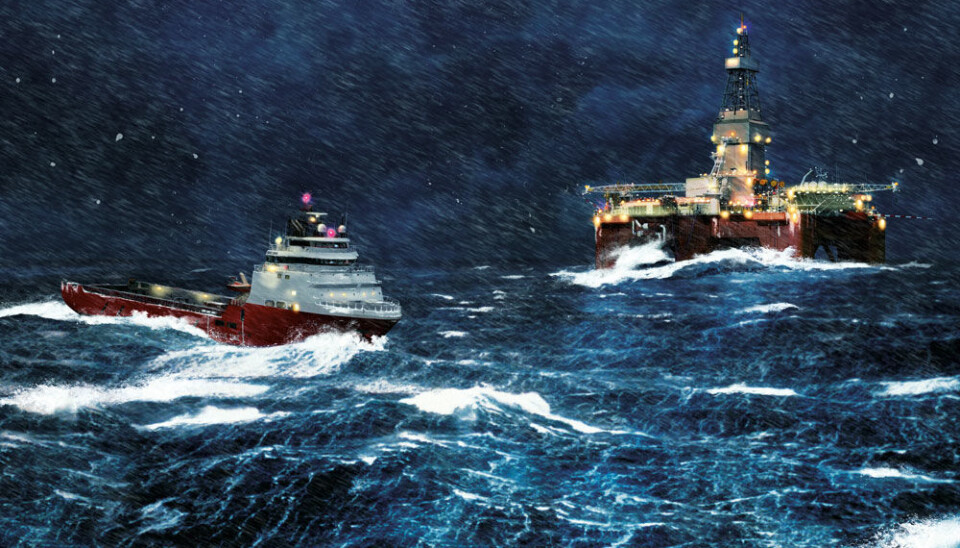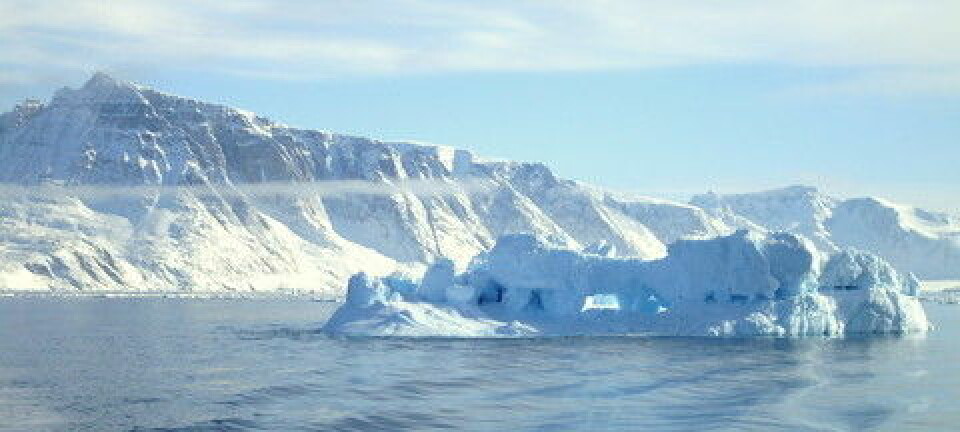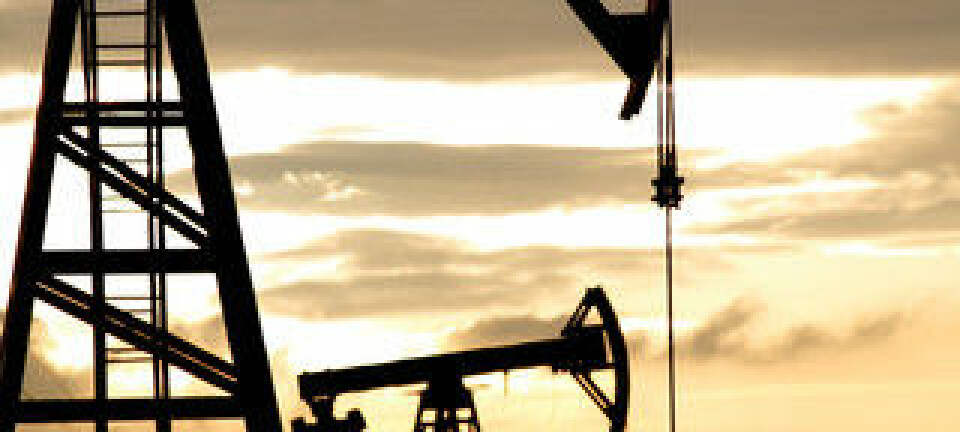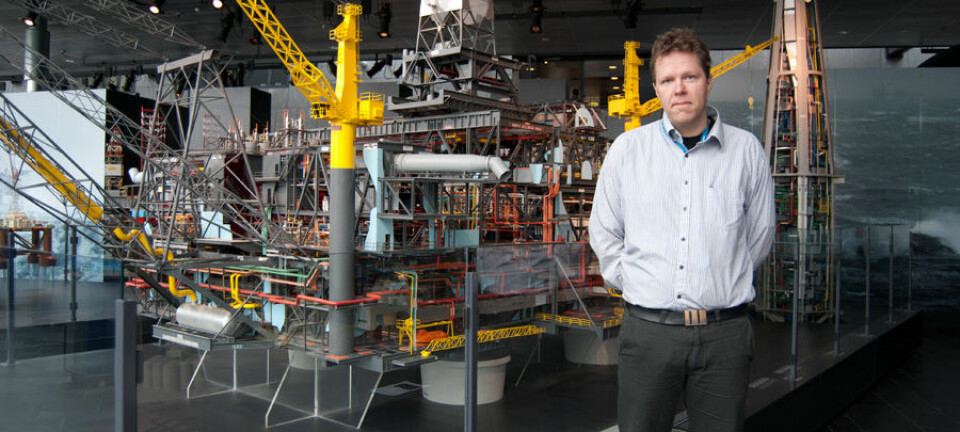This article was produced and financed by University of Stavanger

Working under extreme conditions
The northward shift of Norway’s oil industry means it must adjust to temperatures down to -30°C, storms, sleet and snow, and drift ice. And to the blackest night.
Denne artikkelen er over ti år gammel og kan inneholde utdatert informasjon.
“Try to imagine changing a tyre in freezing weather, snow and darkness,” says professor Tore Markeset, a specialist in cold climate technology at the University of Stavanger (UiS).
That is his way of visualising the challenges facing oil companies seeking to produce oil and gas from the far north of the Norwegian continental shelf (NCS).
Weather, winter darkness, vast distances, and safety and emergency response challenges for petroleum facilities in the Barents Sea will all be more extreme than in the North Sea.
“Compared with our expertise from the southern NCS, we know little about how to run an offshore production installation in a cold climate,” adds professor Ove Tobias Gudmestad at the UiS.
Both he and Markeset are active in teaching, research and finding solutions for developing fields in areas with Arctic conditions.
Opened the Barents Sea
The Norwegian government opened the southern part of Norway’s Barents Sea sector for petroleum operations in the early 1980s. Activity was high but finds few, so interest declined.
But enthusiasm for these waters has recovered sharply in the recent past, particularly after the Skrugard oil discovery was made during 2011.
Promising seismic data, several large oil and gas finds and new technology mean that a growing number of oil companies are discussing opportunities to explore further north on the NCS.
Norway’s Statoil company announced earlier this autumn that it will more than treble its spending on technology for Arctic waters from 11 million Euro in 2012 to 34 million Euro next year.
The increased interest in the far north reflects not least clear government policies, with petroleum and energy minister Ola Borten Moe talking enthusiastically about Barents Sea activities.
Norway currently has one gas production facility operating in the southern Barents Sea. This Snøhvit field has been on stream since 2007.
And operator Eni aims to bring its Goliat oil development into production in 2014. Both that field and Snøhvit lie north-west of Hammerfest, 85 and 140 kilometres from land respectively.
Skrugard, for its part, is located roughly 100 kilometres further north-west from Snøhvit and is expected to come on stream during 2018.
Unpredictability
Climate is the main challenge for impatient oil companies and official agencies, says Gudmestad. “It’s unpredictability for much of the year which is really special about the far north.
“Weather conditions in these waters differ from the North Sea in terms of low temperatures, icing, fog, heavy snowfalls and sudden changes.”
The North Sea weather is easier to forecast, he notes. “When a low pressure area over Iceland moves east, we know it’ll bring bad weather and can plan operations accordingly.
“In the Barents Sea, however, deep troughs of low pressure develop at the interface between ice and open water. These can’t be predicted, and may create sudden storms and hurricanes.”
Wind and waves have much to say for the safety of shipping, fishing and offshore operations. So accurate weather forecasts are important.
With fewer monitoring stations gathering data in the Arctic, however, forecasting in the Barents Sea is less accurate than in the North Sea.
Longer
The further north you go, the longer the winter becomes and the shorter the summer season. A good deal of offshore work must necessarily be squeezed into the latter. But the weather in these brief months may not allow planned activities to go ahead.
Arctic conditions can also mean that equipment fails or breaks down in unfamiliar ways, or more frequently than is the case in warmer regions.
Repairing broken equipment is also likely to take more time, or preventive maintenance may be necessary to make sure that the equipment functions properly.
“Things will take longer,” explains Markeset. “If you need to make repairs but the equipment is covered in snow, you’ll have to dig it out before the job can begin.
“It’s also harder to work in a temperature of -30°C than in 10°C. Putting small screws into place is a slow business with gloves on.”
The more frequently equipment breaks down and the longer it takes to repair, the less time will be available for producing oil and gas, he points out.
“When we invest in a production facility for the far north, it must be up and running for as much of the time as possible so that we can produce profitably.
“A huge problem would be faced if an installation failed to cope with the local climate. We’d be left with a massive and expensive machine which yields little.”
WinterisationAmong the issues he and Gudmestad work on is winterisation – in other words, tailoring equipment and workplaces so that they can operate normally in a harsh winter climate.
They say that much could be different in the far north, including the need for special steels and equipment when temperatures fall low enough.
Plastics, rubber, metals and lubricants are examples of materials which change their properties under extreme cold, and which must be adapted to the Arctic environment.
Electrical systems, sensors, cables, valves, motors and pumps must all be specially manufactured. Piping, tanks and pumps containing liquids which could freeze have to be kept warm even if the installation shuts down to avoid being burst by frozen fluids.
An increased need to heat equipment and facilities and to provide lighting will boost energy consumption on installations – from heating cables in corridors and on helidecks, for instance.
Enclosed
The cold means that more equipment must be enclosed on units working in the Barents Sea than further south. And that in turn calls for more fans to prevent gas accumulations.
“Outfitting facilities in the far north will be more complex because of the need for heating and increased use of sensors to measure equipment condition,” observes Markeset.
“The companies will rely more on remote monitoring of and support for equipment via centres located in such places as Stavanger or Tromsø.
“Real-time diagnosis of systems will be crucial, making use of the internet, fibreoptic cables, satellites and specially developed sensors.
“A key role will also be played here by experts who could be located either at suppliers or in service companies in Germany, Italy, the USA or elsewhere.”
On the other hand, he points out, equipment protected through proper winterisation technology (such as being enclosed, with heat tracing and special designs) and better monitored with the aid of sensors may actually be more reliable and break down less frequently than in warmer waters.
Distances
Companies must also take account of longer distances to market for delivering oil and gas as well as for providing operational, maintenance and support services, Markeset notes.
“Operators have to make more thorough preparations, keep more spare parts on hand and perhaps have more and better expertise on board the production facility. That’ll all add to costs.”
In addition, facilities operating above the Arctic Circle must take 24-hour winter darkness into account. “We know that more accidents happen at night,” Markeset says.
“An important question which needs to be researched is how the perpetual winter darkness affects work processes on an offshore facility.”
Ice
The south-western Barents Sea is not much troubled by sea ice. The UiS scientists are accordingly looking at opportunities for field development and operation in an environment largely free of sea ice, but where drift ice must nevertheless be expected.
“Ice floes may weigh several hundred tonnes,” Gudmestad points out. “They can be tossed around by waves and driven with great force against an installation, causing serious damage.
“Our present equipment isn’t up to a collision with drift ice. That’ll limit the time we can drill in the northern Barents Sea – unlike year-round drilling in the North Sea.”
He points to the Shtokman gas field in the Russian sector of the Barents Sea, which lies in an area affected by both drift and pack ice.
“Pack ice involves extreme forces. It can exert pressure from every direction. A platform placed in the middle of it must be able to withstand such forces.
“In my view, we shouldn’t aim to position facilities on the NCS in pack ice – in other words, in the northern Barents Sea – to start with.”
He accordingly believes in a gradual advance northwards, in order to learn from conditions at each stage and to keep in step with technological progress.
“Although operations have begun in pack ice off Russia and Alaska, we should aim first and foremost to research and develop production solutions for the south-western Barents Sea.
“This is an area with extreme weather conditions and below-freezing temperatures, but where drift ice only appears now and then.”
Achievable
“Before deciding to build oil installations for the northern Barents Sea, we must know whether this is achievable,” Gudmestad explains.
“Plant availability must be satisfactory so that it’s profitable. We must also think about how to prevent accidents and how to respond should one nevertheless occur.”
His concern is to ensure that equipment, organisation and working methods are tailored to the Arctic environment, and thereby to reduce the probability of undesirable incidents.
“We must, for example, be certain that the evacuation system works in the Arctic. We can’t use freefall lifeboats if there’s ice on the water, to take a case in point.”
Threat
Both he and Markeset are concerned that oil spills in the far north pose a big threat to the vulnerable environment in these waters.
“Much of the existing oil spill clean-up equipment hasn’t been designed to operate in a cold climate and drift ice,” says Markeset.
“We must accordingly come up with better methods for collecting any oil spill in waters where sea ice could be encountered.”
The two UiS scientists do not get involved in Norwegian oil policies, and stress that determining how far north petroleum activities should extend on the NCS is a job for the politicians.
“Our role is to make it technically and organisationally possible to operate in the various sea areas when the government decides to set things going,” says Gudmestad.
“We must, for example, build even more safely in the Barents Sea than in the North and Norwegian Seas, and reduce the probability of oil spills even further.
“That’s precisely because the consequences of such discharges are greater in the far north. We must devote extensive resources and work to avoiding oil spills.”
Translated by: Rolf E. Gooderham

































